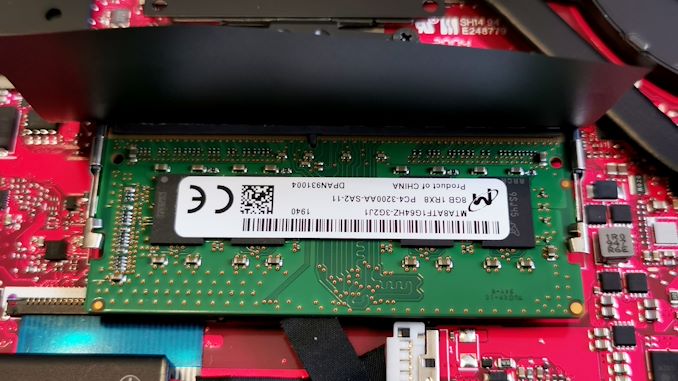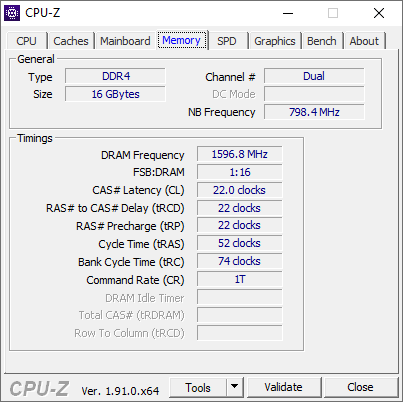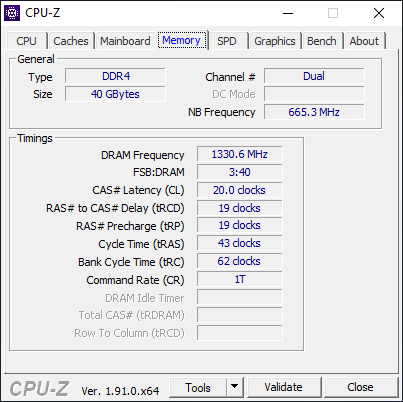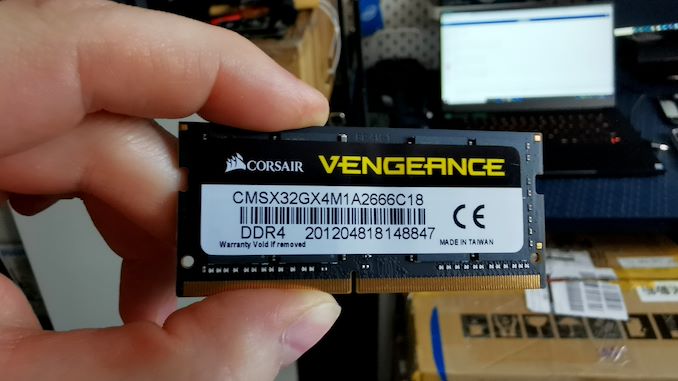AMD’s Mobile Revival: Redefining the Notebook Business with the Ryzen 9 4900HS (A Review)
by Dr. Ian Cutress on April 9, 2020 9:00 AM ESTRyzen 9 4900HS with DDR4-2666 and DDR4-3000
In our ASUS Zephyrus G14, we have a total of 16 GB of DDR4. This is split between a single SO-DIMM module of 8 GB, and a set of 8 GB memory soldered onto the board. AMD will offer a version with 16 / 16, however this might come at a later date.
This memory is running at the AMD recommended for these processors, DDR4-3200. Through our inspection tools, we can tell that this memory is running with subtimings of 22-22-22 with a command rate of 1T. The command rate is certainly good, however the 22-22-22 is a little slower than what we see on a desktop system running at this speed, because here we have a system that conforms to JEDEC’s subtiming requirements.
For our memory testing we wanted to see what speeds and capacities we could achieve. Corsair very kindly sent us some modules of 16 GB DDR4-3000 and a module of 32 GB DDR4-2666. This would give our system either 24 GB or 40 GB total respectively, which for a machine designed to do heavier duty workloads, having >16 GB is certainly welcome, as long as the performance hit isn’t too much.
I installed the 32 GB module, and the system booted first time with no fuss. A quick look to see if all the capacity was seen, and we had a total of 40 GB. The speed was also as expected, at DDR4-2666 but with subtimings of 20-19-19 1T.
However, when we put in the module of 16 GB DDR4-3000, to get a total of 24 GB, the detected speed inside the system was only DDR4-2666. Looking at the module settings, this was because the DDR4-3000 speed was actually an XMP profile, and ASUS has not enabled the ability to set XMP profiles here.
We were able to get DDR4-2666 on the 32 GB module because this is the base frequency and settings for the module. The same with the 8 GB module that came with the system – it was flashed so that the basic SPD setting was DDR4-3200. If users want to get high capacity modules with the faster DRAM speeds on this system, they will have to configure the primary SPD profile of their modules, which isn’t an easy thing to do.
As a result, our tests are going to come down to the 8 GB DDR4-3200 module that came with the system, and compare it to the 32 GB DDR4-2666 module. Note that the latter is an 8+32 configuration, which is expected to run in dual channel for the first 16 GB, and then single channel for the next 24 GB.



With our AI test, there’s a ~20% benefit from having the faster memory, which decreases slightly when moved to a limited power budget.

We didn’t see any difference in something like Cinebench.

There was more of a difference in PCMark 10, however PCM10 isn't that great in showing where the bottlenecks are.
Integrated Graphics Tests


For the Civ 6 graphics test, the difference in performance between the two memory settings is really significant. This sort of game cares less about FPS, however going down to 22 FPS for 1080p Max and No MSAA means that the user probably has to dial that back a bit to get something more reasonable.


Going from plugged in to not plugged in, we didn’t see much of a change with the slower memory, however the DDR4-3200 setting still gets a serious benefit over the DDR4-2666 arrangement.

For Final Fantasy, there a significant change - moving up from DDR4-2666 to DDR4-3200 affords a +30% improvement.
Discrete Graphics Tests




In each case, the faster DRAM actually improves discrete graphics performance.
Quick Thoughts
Overall, 16 GB of memory in a system like this isn't the best configuration - people who need the power are going to likely want 32 GB. However, users putting in their own fast module when buying the 16 GB version are going to have to be careful about the performance. Both the integrated graphics and the discrete graphics take a knock on performance going down from DDR4-3200 to DDR4-2666.















267 Comments
View All Comments
ingwe - Thursday, April 9, 2020 - link
This is very exciting! Especially those battery life numbers.shabby - Thursday, April 9, 2020 - link
Wow ya i was hoping it would at least match intel not double intels battery life lolBigMamaInHouse - Thursday, April 9, 2020 - link
CB R20 Scores are wrong Again :-)Cooe - Thursday, April 9, 2020 - link
The scores are right, they are just labeled wrong lol.SolarBear28 - Thursday, April 9, 2020 - link
@IanCutress The scores should be reversedSamus - Friday, April 10, 2020 - link
It isn't just exciting. It's shocking. AMD finally has a viable notebook CPU.Now they need to come up with something worthy against the U series for ultraportables because the current crop Ryzen U parts (like the Pro 3500U) are a tough pill to swallow since they seem to run closer to 35w under any sort of load.
Gondalf - Friday, April 10, 2020 - link
Here i can see only and AMD 8 cores SKU beating a 6 cores one. There is nothing to be shocked.Try a 8 cores Intel laptop instead, equipped with a new intel SKU and not with one shipped one year ago.
Qasar - Friday, April 10, 2020 - link
and what if the 8 core intel laptop couldnt compete with this one, then what ? would you find a way to make up some lame BS reason as to why it still lost??? come one gondalf, get a lifeGondalf - Sunday, April 12, 2020 - link
Pretty pointless to compare a 6 core cpu with a 8 core one.Moreover the article is rushed because Intel SKUs have a 15ms delay to go from idle to max turbo.
Very likely the Intel Laptop suffer of bad settings or wrong/obsolete bios. Same applies to power measures, with a 80Wh battery an Intel laptop can last around 10 hours browsing web with GPU down. My 38Wh battery give me 5 hours of the same workload, with GPU down.
My bet Intel laptop was with GPU up under the test.
So better wait less rushed reviews to judge.
Qasar - Sunday, April 12, 2020 - link
pretty pointless to try everything you can do to give intel excuses as to why they are losing gondalf, even if intel had more cores, they would still be losing, i believe zen 2 desktop vs intels desktop cpus show this, more cores for intel, and intel still looses on most tests, but yet if it was the other way around, it would be ok, and you would just bash amd for making an inferior product. either way, your just trying to come up with lame BS as to why intel lost, like most i bet, knew you would. very likely, intel just has the inferior product right now.